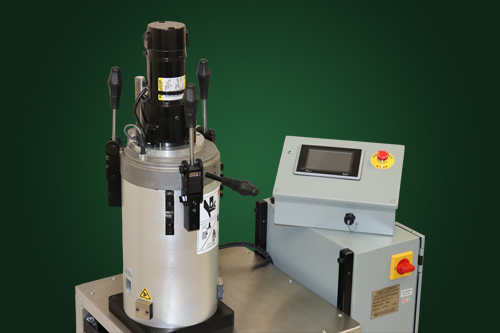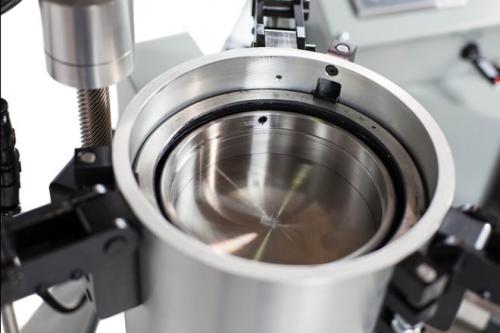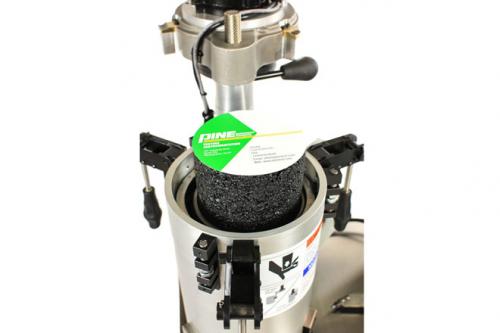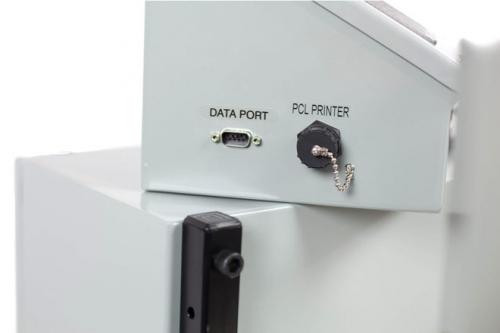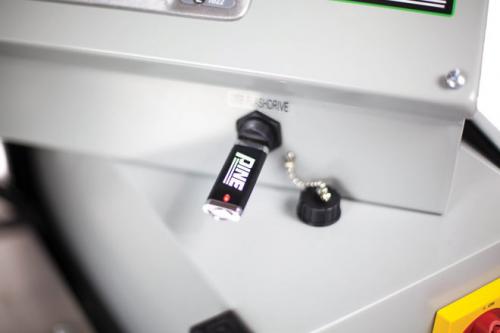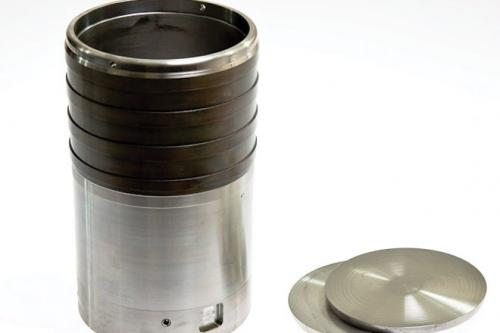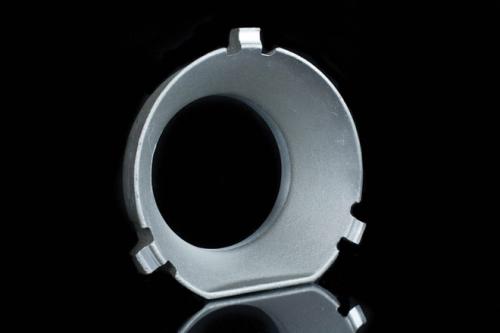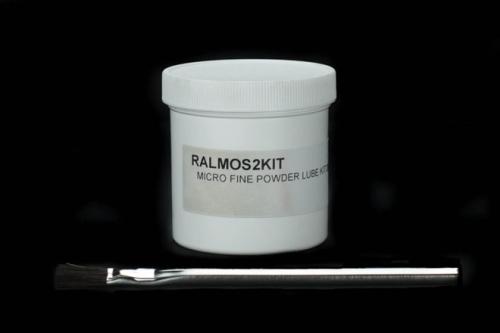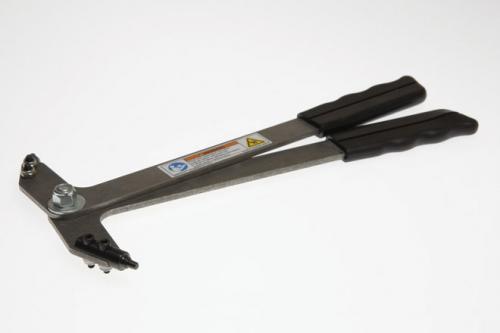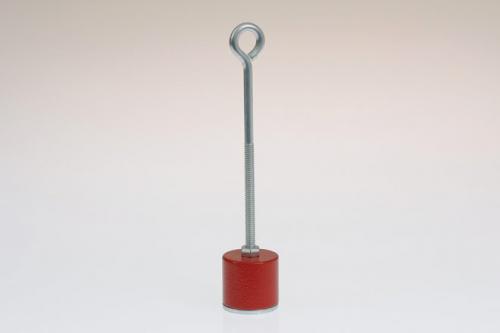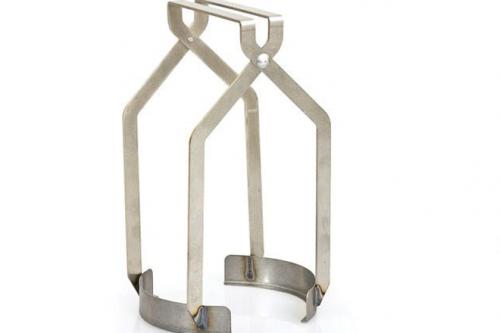GB1 Brovold Superpave Gyratory Compactor
Part # AFGB1A
Available Factory Direct
Email us for a quote
IMPORTANT UPDATE!
The GB1 is nearing the end of its production phase but not the end of its service phase. Pine is exploring the next generation of this design.
Pine Test Equipment, Inc.’s GB1 Brovold Superpave Gyratory Compactor compacts asphalt specimens.
The System
A hydraulic system and an integrated industrial computer drive the GB1. Users define height and number of gyrations using a touchscreen control panel. Angle of gyration and pressure are fixed. The GB1 compacts material at a constant pressure and angle of gyration. It gyrates at a fixed speed. The system extrudes compacted specimens out the top of the machine. The enclosed compaction chamber keeps the user safe. And, two USB ports make exporting data simple.
Specimen Size
The GB1 compacts only 150-mm specimens using 150-mm Mold Assemblies.
Compaction Modes
The GB1 Brovold Superpave Gyratory Compactors makes specimens to a specified height or number of gyrations. Enter the desired height and set the number of gyrations to 299, the maximum allowed, to make specimens to a desired height. Enter the desired number of gyrations and set the height to 10.0 mm, the minimum, to make specimens with a desired number of gyrations.
Portability
The GB1 weighs only 304 pounds and is self-contained. As a result, it is ideal for on-site testing and mobile labs. Roll it into the bed of a pickup truck. Lift it into a van. You can take it just about anywhere.
Standards Compliance: AASHTO T 312 ASTM D6925
Operation Manual: Request a Digital Copy
Available Logbook Sheets for Download:
Technical Support and Service:
- Technical support via telephone and email.
- Annual calibration and repair services
G2 and GB1 Product Comparison
**Upgrade Available **
Transfer data to a USB stick and print to PCL laser printer from GB1 serial numbers 5642 or lower with data logger. Serial numbers 5643 and higher include upgrade.
Power Requirements:
AFGB1A: 115 VAC(±10%), 15 Amp, 60 Hz, 1 ph
Dimensions:
760 mm wide x 540 mm deep x 1410 mm high
(30.0 inch x 21.3 inch x 55.4 inch)
Weight:
Approximately 138 kg (304 lb)
Applied Pressure:
600 ± 5 kPa
Note: The applied pressure is fixed.
Speed of Gyration:
30 ± 0.5 gyrations per minute, factory set
Adjustable range of 20 – 40 gyrations per minute
Note: Users can adjust the speed of gyration.
System:
Electrohyrdaulic
Number of Gyrations:
0 – 299 gyrations
Minimum Specimen Height:
10.0 mm
External Mold Dimensions:
171.4 mm OD x 281.4 mm tall
Angle of Gyration:
0.82 ± 0.02° or 1.16 ± 0.02° Internal Angle or 1.25 ± 0.02° External Angle
Specify at the time of order.
Note: The angle of gyration is fixed.
Mold Weight (empty):
9.1 kg (20.0 lbs.)
Maximum Mold Temperature Rating:
175°C (350°F)
Modes of Operation:
Compact to number of gyrations or specified height.
Note: Users set the desired mode of operation.
Data Acquisition:
Gyration number
Specimen height (mm)
Data Output Options:
(2) USB Ports
USB Flash Drive or Laser Printer (optional)
Internal Mold Dimensions (Space Available for Loose Asphalt):
150.0 mm +0.0/-0.1 mm ID x 214.7 mm tall
Note: Molds meet the requirements of AASHTO T 312 and ASTM D6925.
Internal Data Storage:
Results from 10 tests are retained in memory.
Part Number
Part Description
RATS90
Digital Stopwatch
Part Number
Part Description
*Call Us*
Laser Printer
Part Number
Part Description
EDLQ6BAT
Mitsubishi Replacement Battery for AFGB1's with Serial Numbers of 5817 and Higher
MAINTENANCE SCHEDULE:
Timing Lift Screw
Adjust the Timing Lift Screw if the gyratory head fails to raise and clear the tube when you open the compaction chamber
Pressure Plate Screws
Check weekly with a 3/16″ Allen wrench.
Clamp Adjustment
Keep all three clamps equally tight.
Mold Retaining Latches
Remove debris from around these latches after every specimen.
Clean
Remove debris and wipe metal surfaces with WD-40.
Battery
Under normal usage, the battery should last 4-5 years unless indicator indicates otherwise.
LUBRICATION SCHEDULE: View Video on Lubricating a GB1
Mold Top Plate
Before each specimen. Apply Moly-Grade Anti-Seize Lubricant (CLGSM0S2).
Gyratory Head
Once a day or every 6 specimens. Apply Moly-Grade Anti-Seize Lubricant (CLGSM0S2).
Tapered Bearing
After each specimen. Redistribute the lubricant after each specimen.
Once a week or every 30 specimens. Apply fresh Moly-Grade Anti-Seize Lubricant (CLGSM0S2).
Pressure Plate
Before each specimen. Apply Moly-Grade Anti-Seize Lubricant (CLGSM0S2).
Spherical Bearing
Once a day or every 6 specimens. Apply Moly-Grade Anti-Seize Lubricant (CLGSM0S2).
Gyratory Head & Clamp Recesses
As needed. Apply Moly-Grade Anti-Seize Lubricant (CLGSM0S2).
Gyratory Head Lift Nut
As needed. Apply a light grease or SAE 30 oil. Do not put lubricant on the threaded rod.
INSPECTION SCHEDULE:
Hydraulic System
Check the oil level after the first month of operation and every 6 months thereafter.
Mold Retaining Latches
Check for rounding or chipping of the mold latches periodically.
What should be considered in identifying a location for a machine?
- A sturdy, approximately level floor is important. The machine weighs about 880 lb. (400 kg) and is top heavy.
- The machine can be installed in a mobile lab. Holes are provided in the lower frame bracket to secure the machine to the floor.
- The minimum floor space requirement is 30.0 inches wide by 21.3 inches deep. Be sure to allow additional space on the right side of the machine for access to the USB data port.
- Allow space on either side of the machine for access to service it when necessary if there is insufficient room to move the machine around for servicing.
- The minimum vertical space necessary is about 55.4 inches.
- Provide access to an appropriate power supply for the machine purchased.
How movable is the machine?
- The machine comes with a set of wheels and handles installed. Once the machine is off the skid, it can be moved a short distance by a single person. Care must be taken, however, because of the machine’s high center of gravity.
- Three (3) lifting eyes are located on the top of the machine to provide a proper location to connect lifting apparatus.
- The lower frame of the machine is configured to receive fork truck forks.
How often does a machine need calibrated?
- AASHTO R 18 specifies that a gyratory compactor should be verified every 12 months.
- ASTM D6925-15 Section 6.2 specifies that a gyratory compactor should be calibrated annually or whenever there is reason to doubt the stability of the machine’s operation.
- AASHTO R 18 Section 6.2.1.3. specifies that equipment that may be affected by moving it to a new location or environment should be calibrated, standardized, or checked before being placed into service.
- ASTM D6925-15 Section 6.3 specifies that calibration should be verified after it is moved to a new location.
What should your shipment of a new AFGB1 look like?
Contact Us
-
Specifications
Power Requirements:
AFGB1A: 115 VAC(±10%), 15 Amp, 60 Hz, 1 ph
Dimensions:
760 mm wide x 540 mm deep x 1410 mm high
(30.0 inch x 21.3 inch x 55.4 inch)Weight:
Approximately 138 kg (304 lb)
Applied Pressure:
600 ± 5 kPa
Note: The applied pressure is fixed.Speed of Gyration:
30 ± 0.5 gyrations per minute, factory set
Adjustable range of 20 – 40 gyrations per minute
Note: Users can adjust the speed of gyration.System:
Electrohyrdaulic
Number of Gyrations:
0 – 299 gyrations
Minimum Specimen Height:
10.0 mm
External Mold Dimensions:
171.4 mm OD x 281.4 mm tall
Angle of Gyration:
0.82 ± 0.02° or 1.16 ± 0.02° Internal Angle or 1.25 ± 0.02° External Angle
Specify at the time of order.
Note: The angle of gyration is fixed.Mold Weight (empty):
9.1 kg (20.0 lbs.)
Maximum Mold Temperature Rating:
175°C (350°F)
Modes of Operation:
Compact to number of gyrations or specified height.
Note: Users set the desired mode of operation.Data Acquisition:
Gyration number
Specimen height (mm)Data Output Options:
(2) USB Ports
USB Flash Drive or Laser Printer (optional)Internal Mold Dimensions (Space Available for Loose Asphalt):
150.0 mm +0.0/-0.1 mm ID x 214.7 mm tall
Note: Molds meet the requirements of AASHTO T 312 and ASTM D6925.Internal Data Storage:
Results from 10 tests are retained in memory.
-
Calibration
Part Number
Part Description
RATS90
Digital Stopwatch
-
Accessories
Part Number
Part Description
*Call Us*
Laser Printer
-
Consumables
Part Number
Part Description
EDLQ6BAT
Mitsubishi Replacement Battery for AFGB1's with Serial Numbers of 5817 and Higher
-
Maintenance
MAINTENANCE SCHEDULE:
Timing Lift Screw
Adjust the Timing Lift Screw if the gyratory head fails to raise and clear the tube when you open the compaction chamber
Pressure Plate Screws
Check weekly with a 3/16″ Allen wrench.
Clamp Adjustment
Keep all three clamps equally tight.
Mold Retaining Latches
Remove debris from around these latches after every specimen.
Clean
Remove debris and wipe metal surfaces with WD-40.
Battery
Under normal usage, the battery should last 4-5 years unless indicator indicates otherwise.
LUBRICATION SCHEDULE: View Video on Lubricating a GB1
Mold Top Plate
Before each specimen. Apply Moly-Grade Anti-Seize Lubricant (CLGSM0S2).
Gyratory Head
Once a day or every 6 specimens. Apply Moly-Grade Anti-Seize Lubricant (CLGSM0S2).
Tapered Bearing
After each specimen. Redistribute the lubricant after each specimen.
Once a week or every 30 specimens. Apply fresh Moly-Grade Anti-Seize Lubricant (CLGSM0S2).Pressure Plate
Before each specimen. Apply Moly-Grade Anti-Seize Lubricant (CLGSM0S2).
Spherical Bearing
Once a day or every 6 specimens. Apply Moly-Grade Anti-Seize Lubricant (CLGSM0S2).
Gyratory Head & Clamp Recesses
As needed. Apply Moly-Grade Anti-Seize Lubricant (CLGSM0S2).
Gyratory Head Lift Nut
As needed. Apply a light grease or SAE 30 oil. Do not put lubricant on the threaded rod.
INSPECTION SCHEDULE:
Hydraulic System
Check the oil level after the first month of operation and every 6 months thereafter.
Mold Retaining Latches
Check for rounding or chipping of the mold latches periodically.
-
FAQs
What should be considered in identifying a location for a machine?
- A sturdy, approximately level floor is important. The machine weighs about 880 lb. (400 kg) and is top heavy.
- The machine can be installed in a mobile lab. Holes are provided in the lower frame bracket to secure the machine to the floor.
- The minimum floor space requirement is 30.0 inches wide by 21.3 inches deep. Be sure to allow additional space on the right side of the machine for access to the USB data port.
- Allow space on either side of the machine for access to service it when necessary if there is insufficient room to move the machine around for servicing.
- The minimum vertical space necessary is about 55.4 inches.
- Provide access to an appropriate power supply for the machine purchased.
How movable is the machine?
- The machine comes with a set of wheels and handles installed. Once the machine is off the skid, it can be moved a short distance by a single person. Care must be taken, however, because of the machine’s high center of gravity.
- Three (3) lifting eyes are located on the top of the machine to provide a proper location to connect lifting apparatus.
- The lower frame of the machine is configured to receive fork truck forks.
How often does a machine need calibrated?
- AASHTO R 18 specifies that a gyratory compactor should be verified every 12 months.
- ASTM D6925-15 Section 6.2 specifies that a gyratory compactor should be calibrated annually or whenever there is reason to doubt the stability of the machine’s operation.
- AASHTO R 18 Section 6.2.1.3. specifies that equipment that may be affected by moving it to a new location or environment should be calibrated, standardized, or checked before being placed into service.
- ASTM D6925-15 Section 6.3 specifies that calibration should be verified after it is moved to a new location.
What should your shipment of a new AFGB1 look like?
-
Contact Us
Contact Us




